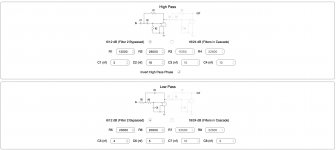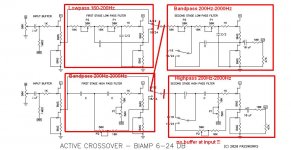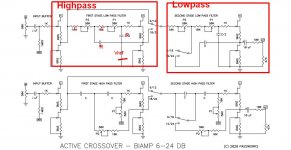I was a about to order three boards to combine my vacation with crossover building, but alas! they are sold out. Are new boards in the works?
Sign up for in stock updates from the store. In an earlier post last week Nelson said more would be going in to the store soon
Slowly reading thru the info about this Xover and, if I've got it right, I can add a 6dB boost at 30Hz plus the 12dB/oct low pass filter set for 150 - 180Hz for the 15" bass driver in B2 alignments, and still have the full array of options for the high pass filter for 8" Betsy driver in the 'Tombstone' OB, yes?
There is no boost or eq available in this crossover. It is simply an adjustable crossover, no fixed slopes or crossover frequencies.
Thanks Roger, how about 6dB low pass first filter at 30Hz followed by 12dB filter at 160Hz for the second filter and retain the full options of the high pass filters?
Or do I have to add a complete new stage (Burson V6, for example) to obtain that 6dB boosted profile at 30Hz to achieve the required response for the 15" bass driver in the B2 alignment?
The 150W amplifier produces full output at a 1V rms input signal so reduced signal levels below unity gain are okay - bass driver is 97dB efficient so never going to need amplifier full power output.
My old LC Audio electronic Xover based on the simple B1 buffer project of some years ago has been adjusted to do this with an active variable bass gain at 30Hz (6 -> 12dB gain) and a following 12dB filter at 150Hz.
Or do I have to add a complete new stage (Burson V6, for example) to obtain that 6dB boosted profile at 30Hz to achieve the required response for the 15" bass driver in the B2 alignment?
The 150W amplifier produces full output at a 1V rms input signal so reduced signal levels below unity gain are okay - bass driver is 97dB efficient so never going to need amplifier full power output.
My old LC Audio electronic Xover based on the simple B1 buffer project of some years ago has been adjusted to do this with an active variable bass gain at 30Hz (6 -> 12dB gain) and a following 12dB filter at 150Hz.
I am unfamilar with your speakers. Can you show us more of them? Is it an open baffle 15" bass driver that you want to equalize and have low pass filtered?
Hi Rodger,
The bass drivers are from our last local manufacturer called Lorantz who produce mainly 'pro-drivers', but no hifi finished speakers - these ones are a prototype pseudo 'hifi' speaker designed to go down to 30Hz in an 85 litre B2 chamber and with flat freq response up to about 1.5kHz - they were designed to work without ports (B2), and a 6db bass boost instead of the usual 12dB (a distortion reducing requirement) - they're very low distortion like all their drivers and 96dB/w efficient - it's a bit of a shame to restrict them to only bass response but box design restricts higher response to maybe 250Hz.
The 'downside' is that the clarity/dynamics of the bass exaggerates the room acoustic aberrations so require definite absorption/diffusion/trapping controls
The Betsy drivers are the FR drivers from Wild Burro Audio in the States - the Tombstone baffle is a small Decware/Caintuck design and supports the 8" FR driver down to nearly 80Hz if positioned on the floor - up in the air on top of the bass boxes, it's about 140Hz, hence the Xover freq above 150Hz.
The bass drivers are from our last local manufacturer called Lorantz who produce mainly 'pro-drivers', but no hifi finished speakers - these ones are a prototype pseudo 'hifi' speaker designed to go down to 30Hz in an 85 litre B2 chamber and with flat freq response up to about 1.5kHz - they were designed to work without ports (B2), and a 6db bass boost instead of the usual 12dB (a distortion reducing requirement) - they're very low distortion like all their drivers and 96dB/w efficient - it's a bit of a shame to restrict them to only bass response but box design restricts higher response to maybe 250Hz.
The 'downside' is that the clarity/dynamics of the bass exaggerates the room acoustic aberrations so require definite absorption/diffusion/trapping controls
The Betsy drivers are the FR drivers from Wild Burro Audio in the States - the Tombstone baffle is a small Decware/Caintuck design and supports the 8" FR driver down to nearly 80Hz if positioned on the floor - up in the air on top of the bass boxes, it's about 140Hz, hence the Xover freq above 150Hz.
There is no boost or eq available in this crossover. It is simply an adjustable crossover, no fixed slopes or crossover frequencies.
Would the other crossover be better? What are the pros cons of these designs? The other one is harder to design?
Would the other crossover be better? What are the pros cons of these designs? The other one is harder to design?
What other crossover? If you need more than a conventional active crossover, maybe like the LXmini crossover which can alter the frequency response for each driver. Then the 6-24XO is not suitable. If you want to equalize the 6-24XO is not what you want.
Still, a DSP-based crossover can do a lot more than that. It is all up to what you want the crossover to do.
Hi Rodger,
The bass drivers are from our last local manufacturer called Lorantz who produce mainly 'pro-drivers', but no hifi finished speakers - these ones are a prototype pseudo 'hifi' speaker designed to go down to 30Hz in an 85 litre B2 chamber and with flat freq response up to about 1.5kHz - they were designed to work without ports (B2), and a 6db bass boost instead of the usual 12dB (a distortion reducing requirement) - they're very low distortion like all their drivers and 96dB/w efficient - it's a bit of a shame to restrict them to only bass response but box design restricts higher response to maybe 250Hz.
The 'downside' is that the clarity/dynamics of the bass exaggerates the room acoustic aberrations so require definite absorption/diffusion/trapping controls
The Betsy drivers are the FR drivers from Wild Burro Audio in the States - the Tombstone baffle is a small Decware/Caintuck design and supports the 8" FR driver down to nearly 80Hz if positioned on the floor - up in the air on top of the bass boxes, it's about 140Hz, hence the Xover freq above 150Hz.
I am a bit confused about what you want to do.
1. Crossover at 150 Hz, that is what the 6-24XO can do.
2. The description of your speaker is unknown to me, "an 85 litre B2
chamber without ports".
3. What is the look of this boost? Is it a open baffle compensation or what?
The "other crossover" is different to the 6-24XO in this thread. The LX-mini can equalize both the low pass and high pass sections. If it is the equalizing you need and do not need steeper slopes, then chose the LX-mini.
When we set the knee by choosing c and c/2 values, does the pots make the filters steeper only or do they move the knee frequency lower and higher too, if so how much?
I want to experiment first order and second order filter between 160hz to 200hz and 1200hz to 2000hz in mine. Can all this be done with fixing resistors and just turning the pots?
I want to experiment first order and second order filter between 160hz to 200hz and 1200hz to 2000hz in mine. Can all this be done with fixing resistors and just turning the pots?
Thanks a lot!
Here is what I have found out to be a good starting point for me for crossing around 1600-1800hz for my mid and tweeter. Does this look all right?
However I can not understand how I can add the 200hz hi-pass to this. I need 200 high pass and 1600hz low pass (a band pass) for my lower mid and 1600hz high pass for my tweeter.
The bass part has its own crossover and that part can play up to about 180-200hz.
Here is what I have found out to be a good starting point for me for crossing around 1600-1800hz for my mid and tweeter. Does this look all right?
However I can not understand how I can add the 200hz hi-pass to this. I need 200 high pass and 1600hz low pass (a band pass) for my lower mid and 1600hz high pass for my tweeter.
The bass part has its own crossover and that part can play up to about 180-200hz.
Attachments
You will have to do separate calculations and use two of the filter boards with different components, one set for 200 and one for 1600.
to Kodomo #356
Hello Kodomo,
you could try something like this (see pics).
But the Highpass would miss a bufferstage at the input and the problem with the volumepots?....😕
Only some thoughts...
Greets
Dirk
p.s.: Or you use 2 boards of the 6-24XO
Hello Kodomo,
you could try something like this (see pics).
But the Highpass would miss a bufferstage at the input and the problem with the volumepots?....😕
Only some thoughts...
Greets
Dirk
p.s.: Or you use 2 boards of the 6-24XO
Attachments
to Kodomo #356
I think the best way would be to use 2 boards of the 6-24XO.
One board with the lowpass (160-200Hz) for the bass; highpass(above (1600-200Hz) for the tweeter
and one board (daisychain the two filters) for the bandpass (160-2000Hz).
You could also make one stage of the lowpassfilter to a highpassfilterby changing the Cs to Rs and Rs to Cs (in the filter) and vice versa.
Then you would have full adjustability with the volumepots and buffers at the input. I think you would have to cut traces at the input or use jumpercables.
And you could play with the different slopes.....
Greets
Dirk
I think the best way would be to use 2 boards of the 6-24XO.
One board with the lowpass (160-200Hz) for the bass; highpass(above (1600-200Hz) for the tweeter
and one board (daisychain the two filters) for the bandpass (160-2000Hz).
You could also make one stage of the lowpassfilter to a highpassfilterby changing the Cs to Rs and Rs to Cs (in the filter) and vice versa.
Then you would have full adjustability with the volumepots and buffers at the input. I think you would have to cut traces at the input or use jumpercables.
And you could play with the different slopes.....
Greets
Dirk
You are playing with the electrical curves. It is the acoustical response we want to see. That is what counts.
- Home
- Amplifiers
- Pass Labs
- DIY biamp 6-24 crossover




